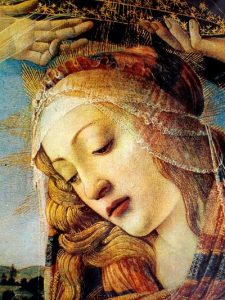For the third Sunday of Advent, FCC’s former assistant pastor, the Rev. Janet Abel, shared the stories of Mary and Elizabeth, the visit between a very young and pregnant Mary and St. Elizabeth, her older cousin who is pregnant with Jesus’s cousin, John the Baptist.
Rev. Abel noted that the third Sunday of Advent was traditionally known as Joy Sunday, symbolized by the pink candle on the Advent Wheel — pink symbolizing love, of course, and Mary.
Rev. Abel shared what intrigued her about this visit — a pregnant Mary, in a time when women didn’t necessarily travel in that way.
“I want to focus on this extraordinary visit. Why would Mary leave home to travel a long distance to visit her cousin Elizabeth?” she wondered.

Reviewing the story as it appears in Luke 1:39-56, Rev. Abel pointed out that the distance between Nazareth and “into the hill country … into a city of Judah” that was close to 100 miles (130 or more kilometers) — a big deal to travel that distance, in that condition, then.
“What concerns me here — what concerns us — is not “did this really happen this way?” or to get so caught up in how these two women — one too young and one too old — get pregnant.”
But rather that “There’s mystery here, and meaning; meaning especially, because Luke’s story is our story.”
“Blessed is she who believed that there would be a fulfillment of what was spoken to her by the Lord”
“And blessed are we who believe … believe that we the beloved by God are full of grace and chosen by God.”

Rev. Abel continued,
“The Magnificat is the song that Mary sings in response to Elizabeth’s and John’s extraordinary greeting.
These words echo the prayer of Hanna — sung way back when she’s finally pregnant with Samuel — a woman like Elizabeth who waited so long for her prayers to be fulfilled.
Mary’s song isn’t just about herself but about the world, about justice, about the last being first … finally.
It’s about wrongs being righted … finally. About this world that we see, and hear on the news, and see on television, and being reminded that that’s not all there is.
God chose these two very ordinary women to bear extraordinary beings into this world.
That’s what Christmas really is: bearing the extraordinary, the Divine, into this tired, work-a-day hopeless world.
And this world becomes full of hope, and promise, and love, because God chooses us too — you and me — to bear the extraordinary, the Divine, into our worlds.
Blessed are we…always.
Amen.”
Featured Image Credit: The Visitation (painting) by The Visitation, 1491, by Domenico Ghirlandaio, depicts Mary visiting her elderly cousin Elizabeth. PD image, Wikimedia.

